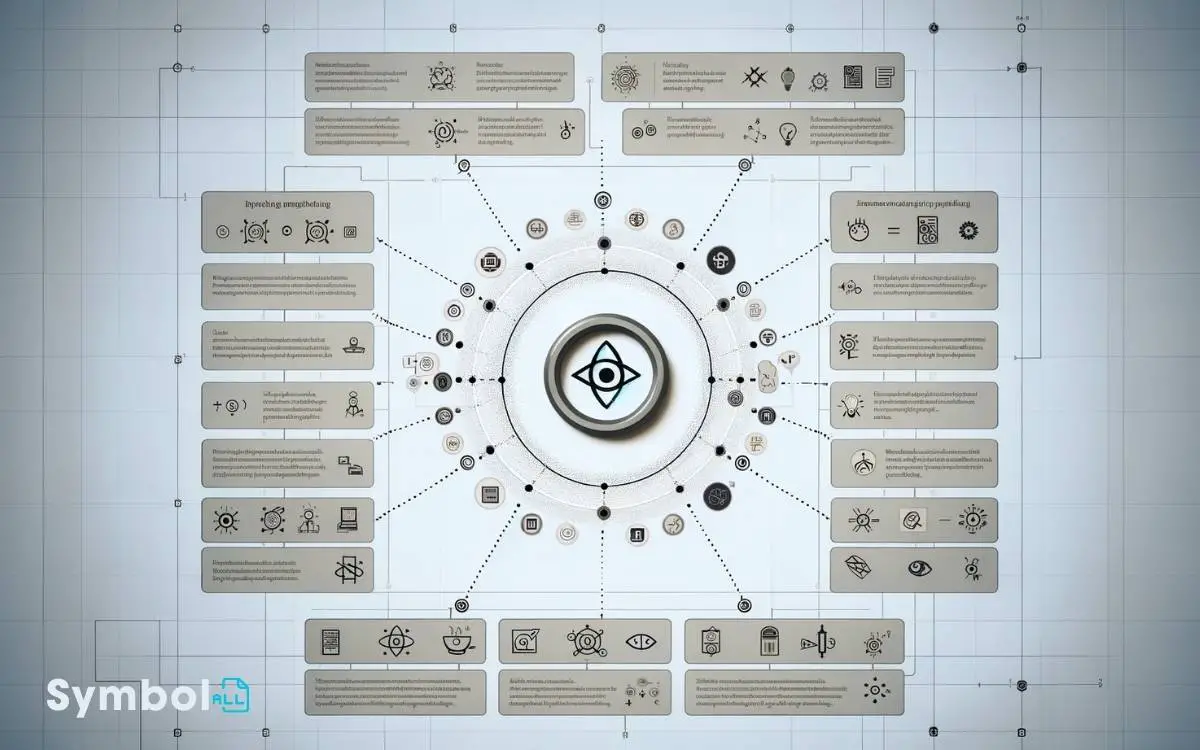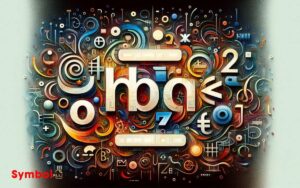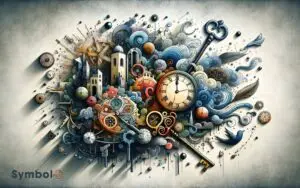What Is the Symbol Used for? Explains!
Symbols are your bridge between the intangible and tangible, a foundational element of human communication. They’ve stemmed from ancient societies, evolving into complex systems that encapsulate beliefs, societal values, and knowledge.
In different cultures, symbols like hieroglyphs or Aztec imagery have preserved wisdom across generations. They’re not just remnants of the past; symbols permeate every facet of modern life.
From the mathematical operators that form the basis of arithmetic to the emojis that convey emotions digitally, symbols encompass the economic, scientific, and digital spheres.
They shape your understanding of the world, guiding through diverse realms of knowledge. Venturing further unveils their deeper essence.

Key Takeaways
The Origin of Symbols
To truly grasp the essence of symbols, it’s essential to delve into their origins, tracing back to ancient human societies that used them as a means to communicate complex ideas and beliefs.
You’ll find that symbols weren’t merely artistic expressions but served as the bedrock for conveying intricate concepts and information.
They bridged the gap between the tangible and the intangible, offering a medium through which abstract thoughts could be represented visually.
This foundational use underscores the human inclination towards encapsulating vast, multifaceted notions within simple, recognizable forms.
Understanding this genesis helps you appreciate how symbols evolved into complex systems of communication, transcending mere pictographs to embody deeper meanings.
This evolution, rooted in the necessity to express and connect, highlights the ingenuity and adaptability of human intellect across cultures and epochs.
Symbols in Ancient Cultures
Delving into the realm of ancient cultures reveals that symbols served as essential tools for communication, embodying complex beliefs and societal values with remarkable precision.
These symbols weren’t merely artistic expressions; they were integral to conveying messages across generations, often encapsulating profound meanings within simple designs.
You’ll find that in ancient Egypt, hieroglyphs weren’t just writing but a complex system intertwining visual and linguistic elements, revealing much about their cosmology and governance.
Similarly, in the Americas, the Maya and Aztec cultures utilized symbols to record astronomical data, religious ceremonies, and even political hierarchies.
This intricate use of symbols allowed for a durable method of preserving knowledge, ensuring that their insights, achievements, and understandings weren’t lost to time.
The Power of Religious Symbols
Exploring the realm of religious symbols, it’s evident they hold profound influence over beliefs, practices, and societal norms. These symbols are not merely illustrations; they’re embodiments of faith, moral values, and the collective consciousness of a community.
To understand their impact, consider the following table which aligns symbols with their associated meanings:
| Symbol | Meaning |
|---|---|
| Cross | Christianity; symbolizes sacrifice and salvation |
| Star of David | Judaism; represents divine protection and the connection between God and humanity |
| Crescent Moon | Islam; signifies guidance and the rhythm of life |
| Om | Hinduism; embodies the essence of the universe |
| Wheel of Dharma | Buddhism; denotes the path to enlightenment |
Each symbol carries layers of significance, guiding adherents in their spiritual journey and fostering a sense of belonging and identity.
Mathematical Symbols Explained
Shifting from religious to mathematical symbols, you’ll find that common arithmetic operators form the foundation of your understanding.
As you progress, advanced mathematical notations offer a precise language for expressing complex ideas beyond basic arithmetic.
Common Arithmetic Operators
In this section, we’ll break down common arithmetic operators, the fundamental symbols that form the backbone of basic mathematics.
You’re likely familiar with the plus sign (+), which signifies addition, the process of combining numbers to increase their total value.
Conversely, the minus sign (-) represents subtraction, the act of deducting one number from another, resulting in a decrease.
Multiplication, denoted by an asterisk (*) or sometimes an ‘x’, involves increasing a number by another number a specified number of times.
Division, symbolized by a forward slash (/) or a division sign (÷), is the operation of distributing a number into equal parts.
Understanding these operators is crucial, as they’re the primary tools for solving a vast array of mathematical problems, laying the groundwork for more complex operations and concepts.
Advanced Mathematical Notations
Having established the basics of common arithmetic operators, let’s now examine the realm of advanced mathematical notations, where symbols serve as the language for expressing more complex ideas and operations.
These notations allow you to delve deeper into the abstract and the precise.
| Symbol | Description |
|---|---|
| ∑ | Represents summation, indicating the sum of a sequence of numbers |
| ∫ | Denotes integration, a fundamental concept in calculus for finding areas, volumes, central points, and many useful things |
| ∂ | Partial derivative symbol, used to indicate the rate of change of a function with respect to one of several variables |
| ∈ | Means “element of,” showing that an item is part of a set |
| ∞ | The symbol for infinity, indicating a quantity without bound or end |
Understanding these symbols is crucial for advancing in mathematical proficiency, enabling you to tackle more sophisticated problems and theories. They serve as the foundation for interpreting complex equations and communicating abstract ideas effectively. For instance, grasping the meaning behind specific symbols, such as understanding what symbol represents inches, allows for precise measurements and accurate problem-solving in geometry and beyond. Building this familiarity equips learners to approach advanced mathematical concepts with confidence and clarity.
Symbolic Logic Basics
As we delve into the basics of symbolic logic, you’ll learn how various mathematical symbols aren’t just shorthand but critical tools for constructing and analyzing logical arguments.
At the heart of symbolic logic is the use of symbols, like ∧ for ‘and’, ∨ for ‘or’, ¬ for ‘not’, → for ‘implies’, and ↔ for ‘if and only if’. These symbols allow you to express complex logical statements succinctly.
For instance, the expression ‘p ∧ q’ means both p and q are true. Understanding how to manipulate these symbols according to logical rules enables you to break down arguments, identify their structure, and evaluate their validity.
Mastering symbolic logic is essential for dissecting theoretical concepts and applying them to real-world scenarios efficiently.
Scientific Symbols and Their Meanings
You’ll find that scientific symbols serve as the essential language of the sciences, enabling precise communication across various disciplines.
By understanding common symbols, you’re equipped to interpret and engage with scientific literature more effectively.
Examining symbols in research contexts further reveals how these notations underpin the formulation and dissemination of scientific ideas.
Understanding Scientific Symbols
To understand the natural world, it’s essential to grasp the meanings behind scientific symbols. These symbols aren’t just arbitrary; they’re the language of science, a understand the natural world, it’s essential to grasp the meanings behind scientific symbols.
These symbolsaren’t just arbitrary; they’re the language of science, a universal shorthand that transcends linguistic barriers. They allow for the concise communication of complex concepts, from chemical elements to mathematical operations.
Each symbol represents a specific concept or idea, providing a common ground for scientists across the globe.
Common Symbols Explained
Diving into the realm of scientific symbols, it’s crucial to understand that each one carries a specific meaning, acting as a key to unlocking complex concepts.
For instance, the symbol ‘H2O‘ represents water, revealing its composition of two hydrogen atoms bonded to one oxygen atom.
Similarly, ‘E=mc^2′, Einstein’s equation, elegantly links energy (E) with mass (m) and the speed of light (c), demonstrating the relationship between mass and energy.
The Greek letter ‘π’ (pi), denotes the ratio of a circle’s circumference to its diameter, a constant in mathematics and physics.
Understanding these symbols isn’t just about memorization; it’s about grasping the fundamental principles they embody, which are foundational to scientific inquiry and discovery.
Symbols in Research Context
Exploring scientific symbols and their meanings unveils the intricate language researchers use to communicate complex ideas succinctly. These symbols are crucial for clarity and efficiency in conveying information.
Here’s a breakdown:
- Δ (Delta) – Represents change or difference in variables. For instance, ΔT means change in temperature.
- λ (Lambda) – Denotes wavelength in physics, often used in light and wave studies to describe the distance between successive crests of a wave.
- Ω (Omega) – Symbolizes ohms, the unit of electrical resistance, indicating how strongly a substance opposes the flow of electric current.
- ∑ (Sigma) – Stands for the sum of a series of numbers. This notation simplifies the representation of addition operations, especially in statistical formulas.
Understanding these symbols enhances your grasp of scientific concepts and research findings.
Currency Symbols Around the World
Navigating the diverse landscape of currency symbols offers a glimpse into the economic identities of countries around the world. Each symbol embodies not just a method of transaction but also cultural significance and historical context.
For instance, the US dollar ($) is recognized globally, symbolizing the United States’ economic influence. Similarly, the Euro (€) represents a collective currency of the European Union, signifying unity and economic stability among its member states.
Japan’s Yen (¥) and the British Pound (£) reflect the economic stature and heritage of their respective nations.
Understanding these symbols isn’t just about recognizing a form of currency; it’s about appreciating the intricate blend of history, culture, and economic strategy that each symbol represents.
This knowledge equips you to decode part of a nation’s identity through its chosen symbol.
Alphabets as Symbolic Systems
Just as currency symbols offer insights into a nation’s economic identity, alphabets serve as complex systems encoding linguistic and cultural narratives.
You’re not just learning letters; you’re uncovering the layers of history and values embedded within each character.
Consider how alphabets:
- Reflect Societal Structures: They can mirror the social hierarchies and class divisions within a culture.
- Evolve with Language: As languages expand and adapt, so too do their alphabets, capturing new sounds and concepts.
- Enable Communication: Beyond mere sounds, alphabets are the backbone of effective communication across time and space.
- Preserve Histories: They hold the key to understanding ancient civilizations, offering insights into the past that have shaped the present.
Digital Age: Emojis and Icons
In the digital age, emojis and icons have become fundamental tools for expressing complex emotions and ideas succinctly. They serve as a bridge between the abstract and the tangible, enabling you to communicate more effectively across digital platforms.
Here’s how they’re typically used:
| Emoji/Icon | Usage |
|---|---|
| 😂 | Expressing amusement or laughter |
| ❤️ | Signifying love or affection |
| 🤔 | Indicating thinking or uncertainty |
| 👍 | Showing approval or agreement |
| 🎉 | Celebrating success or excitement |
This table illustrates the versatile role emojis and icons play in digital communication. They’re not just decorative elements; they’re compact symbols packed with meaning.
By adopting them, you’re equipped to convey nuanced thoughts and feelings in a universally understandable language, transcending cultural and linguistic barriers.
Political Symbols and Their Impact
As you explore the realm of political symbols, it’s crucial to understand their origins, which lay the groundwork for their meanings and influences.
You’ll notice how these symbols shape societal views and behaviors, revealing their powerful impact.
Origins of Political Symbols
Delving into the origins of political symbols reveals how societies have historically used visual representations to embody political ideologies and movements.
Here’s how they’ve developed:
- Ancient Civilizations: Political symbols date back to ancient civilizations, where emblems were used to represent authority and governance.
- Middle Ages: During this period, heraldry became a system of symbols for identifying families and allegiances, influencing political symbols.
- Revolutionary Movements: Symbols like the Phrygian cap became associated with freedom and revolution, signifying the overthrow of tyranny.
- Modern Era: Political parties and movements now adopt logos and symbols that encapsulate their values and objectives, making complex ideologies accessible and recognizable.
Understanding these origins helps you appreciate the depth and power behind the symbols you encounter in political discourse today.
Symbols Influence on Society
Political symbols wield a profound influence on society, shaping public perception and rallying individuals around shared ideologies. You’ve seen them in campaigns, protests, and on national flags, each carrying a weight far beyond its immediate visual impact.
These symbols serve as shorthand for complex political and philosophical ideas, making them accessible to a broad audience. They inspire allegiance, foster community, and sometimes, provoke division.
By encapsulating ideologies in simple, recognizable forms, political symbols efficiently communicate values and beliefs, bypassing lengthy explanations.
They’re not just images or icons; they’re catalysts for social and political movements, embodying the hopes, fears, and aspirations of those they represent.
As such, understanding their influence helps you grasp the undercurrents of societal shifts and the power dynamics at play.
Controversial Symbols Debate
The debate around controversial symbols often centers on their capacity to evoke strong emotions and polarize communities. These symbols, especially in political contexts, wield a significant power to influence public opinion and behavior.
Understanding their impact is crucial for navigating the complexities of social interactions and political discourses.
- Historical Context: Every symbol carries a history that shapes its perception and use in contemporary debates.
- Emotional Resonance: Symbols often bypass rational arguments, tapping directly into deep-seated emotions and beliefs.
- Group Identity: They can unite or divide groups, serving as badges of allegiance or markers of opposition.
- Public Discourse: The controversy surrounding symbols can spark important conversations about values, rights, and societal norms, pushing communities towards reflection and, potentially, reconciliation.
Symbols in Art and Literature
While exploring the realm of art and literature, you’ll find that symbols serve as powerful tools, conveying complex ideas and emotions with simplicity and depth.
| Symbol | Art Example | Literature Example |
|---|---|---|
| The Rose | Renaissance paintings | “The Name of the Rose” by Umberto Eco |
| Water | Hokusai’s “The Great Wave” | “Moby Dick” by Herman Melville |
| The Raven | Picasso’s “The Kitchen” | “The Raven” by Edgar Allan Poe |
| Light and Darkness | Caravaggio’s works | “Heart of Darkness” by Joseph Conrad |
These examples illustrate how symbols are not merely decorative. They hold layers of meaning, shaping perceptions and enhancing narrative depth. Understanding their use allows you to appreciate the nuance in artistic and literary works more fully.
Traffic Signs and Public Symbols
In your daily commute, you encounter a variety of traffic signs and public symbols, each carrying specific instructions and meanings essential for safe and efficient movement.
To navigate this landscape with understanding, consider:
- Stop Signs: Command drivers to halt completely before proceeding, ensuring intersections are navigated safely.
- Pedestrian Crossing Signs: Alert drivers to areas where pedestrians may be crossing, prioritizing pedestrian safety.
- Speed Limit Signs: Indicate the maximum speed allowed, tailored to road conditions and traffic flow.
- No Parking Zones: Inform drivers of areas where parking is prohibited, facilitating smooth traffic and access for emergency vehicles.
These elements work in concert to create a structured and predictable road environment, minimizing confusion and maximizing safety for all road users.
Corporate Logos and Branding
You must recognize that corporate logos serve as the cornerstone of brand identity, encapsulating a company’s essence in a visual form.
The evolution of these logos significantly influences consumer perception and brand loyalty.
Analyzing these changes reveals insights into market trends and company strategies, underscoring the importance of adaptability in branding.
Brand Identity Essentials
Corporate logos and branding serve as the cornerstone of brand identity, encapsulating a company’s essence and values in a visually compelling manner.
To fully grasp their significance, consider the following elements:
- Consistency: Your logo and branding elements must be consistent across all platforms, ensuring a cohesive brand identity that’s easily recognizable.
- Memorability: A well-designed logo stands out, making your brand memorable to consumers and helping it stick in their minds.
- Versatility: Your logo should be adaptable, functioning well in various formats and sizes without losing its impact.
- Relevance: Ensure your branding reflects the current values and trends of your target market, making it more appealing and relevant to your audience.
Understanding these essentials will guide you in creating a powerful brand identity.
Logo Evolution Impact
Over time, the evolution of a company’s logo can significantly influence its brand identity and market perception. You’ve seen logos morph from complex illustrations to sleek, minimalist designs.
This isn’t arbitrary. Each change is a strategic move, reflecting current trends, technological advancements, and consumer expectations.
It’s about staying relevant. When a logo evolves, it signals that the company is responsive and adaptive, qualities highly valued in today’s fast-paced market.
Moreover, a logo’s evolution can reinvigorate interest in the brand, attracting new customers while reassuring existing ones of the brand’s commitment to progress.
Thus, understanding the impact of logo evolution is crucial. It’s not just a change in visuals; it’s a deliberate step towards maintaining or enhancing a company’s position in the competitive landscape.
Hand Gestures as Universal Symbols
Many hand gestures serve as universal symbols, transcending language barriers and cultural differences to communicate specific messages or emotions effectively. You’ll find these gestures deeply ingrained in societal interactions, each carrying a distinct significance.
- Thumbs Up – Universally recognized as a sign of approval or agreement.
- Peace Sign – A symbol of peace or victory, often used to convey goodwill.
- Stop Hand – An open palm facing outward to indicate stopping or the need for pause, universally understood in various contexts.
- Clapping – Used globally to express appreciation, support, or excitement, clapping is a form of non-verbal applause.
These gestures exemplify how non-verbal communication can bridge gaps, fostering a form of understanding that’s both immediate and universal.
The Future of Symbolism
Building on our understanding of universal hand gestures, we’ll now explore how symbolism is likely to evolve in the future.
You’ll see symbols becoming increasingly dynamic, adapting to the rapid changes in global culture and technology. As digital platforms continue to shape communication, expect symbols to transcend traditional boundaries, becoming more inclusive and universal.
This evolution will require a more nuanced understanding, as symbols gain layers of meaning, influenced by context, geography, and even individual perception.
You’ll need to navigate these changes carefully, understanding that what was once a straightforward symbol may now convey multiple, complex ideas.
The future of symbolism isn’t just about new symbols emerging; it’s about the depth and breadth of what existing symbols can communicate, challenging you to engage with them more thoughtfully and critically.
Conclusion
You’ve traversed the rich tapestry of symbols, from their cradle in ancient civilizations to their dynamic role in modern discourse.
These visual shorthand methods, whether cloaked in the sacred, etched in the fabric of mathematics, or emblazoned on the highways of commerce, serve as the silent sentinels of meaning.
As you navigate the evolving landscape of symbolism, remember, each glyph carries a universe of thought, distilled into a mere whisper of ink or pixel, guiding humanity’s endless quest for understanding.






